外贸业务操作流程(中英文)
- 格式:docx
- 大小:12.66 KB
- 文档页数:4

用英语简述外贸流程摘要:1.外贸概述2.外贸流程步骤一:寻找潜在客户和市场3.外贸流程步骤二:发送报价和商务洽谈4.外贸流程步骤三:签订合同5.外贸流程步骤四:生产与物流安排6.外贸流程步骤五:报关与检验7.外贸流程步骤六:货物送达客户8.外贸流程步骤七:售后服务与客户关系维护9.外贸流程的挑战与应对策略10.提高外贸业务的成功率正文:外贸,即对外贸易,是指一个国家与其他国家之间进行的商品和劳务交换。
在全球经济一体化的背景下,外贸对企业的发展和国家经济的重要性不言而喻。
本文将用英语简述外贸流程,以帮助读者更好地了解外贸业务的开展。
1.外贸概述Foreign trade involves the exchange of goods and services between countries.It helps businesses expand their market reach and promotes economic growth.2.外贸流程步骤一:寻找潜在客户和市场To start foreign trade, it"s essential to identify potential customers and target markets.This can be done through online platforms, trade shows, and industry networks.3.外贸流程步骤二:发送报价和商务洽谈Once potential customers are identified, exporters need to send them quotations and engage in business negotiations.This usually involves discussing terms of payment, shipping methods, and other relevant details.4.外贸流程步骤三:签订合同After both parties reach an agreement, a sales contract should be signed.This document outlines the terms and conditions of the deal, including product specifications, pricing, and delivery schedules.5.外贸流程步骤四:生产与物流安排Following the signing of the contract, the exporter arranges for production and logistics.This involves coordinating with factories, transportation companies, and other stakeholders to ensure timely delivery.6.外贸流程步骤五:报关与检验Before shipping the goods, the exporter needs to complete customs declaration and inspection procedures.This ensures that the goods comply with import regulations and standards of the destination country.7.外贸流程步骤六:货物送达客户The goods are then transported to the destination country, where they are cleared by customs and delivered to the client.8.外贸流程步骤七:售后服务与客户关系维护After the delivery, it"s essential to provide after-sales service and maintain customer relationships.This includes addressing any issues or concerns raised by the client and seeking feedback to improve future transactions.9.外贸流程的挑战与应对策略Foreign trade involves various challenges, such as language barriers, cultural differences, and regulatory requirements.To overcome these, exporters should develop a strong understanding of the target market, build a reliable supply chain, and establish efficient communication channels.10.提高外贸业务的成功率To increase the success rate of foreign trade transactions, exporters should focus on developing strong relationships with customers, providing high-quality products and services, and continuously improving their operational efficiency.通过以上简要的外贸流程概述,希望能帮助读者更好地了解外贸业务的基本流程和关键环节。
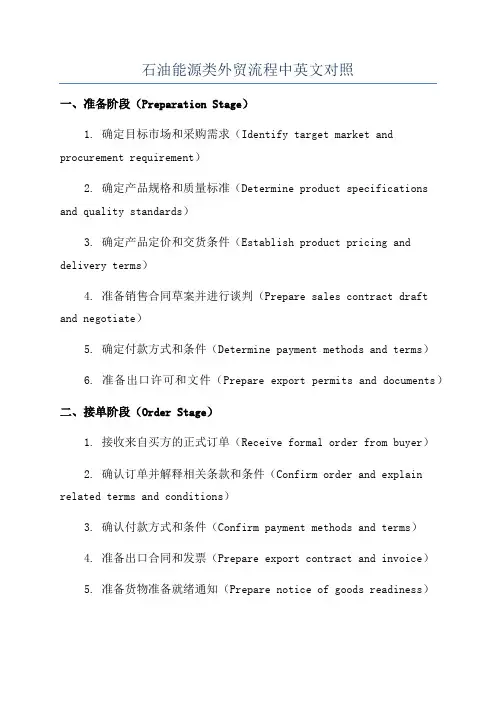
石油能源类外贸流程中英文对照一、准备阶段(Preparation Stage)1. 确定目标市场和采购需求(Identify target market and procurement requirement)2. 确定产品规格和质量标准(Determine product specifications and quality standards)3. 确定产品定价和交货条件(Establish product pricing and delivery terms)4. 准备销售合同草案并进行谈判(Prepare sales contract draft and negotiate)5. 确定付款方式和条件(Determine payment methods and terms)6. 准备出口许可和文件(Prepare export permits and documents)二、接单阶段(Order Stage)1. 接收来自买方的正式订单(Receive formal order from buyer)2. 确认订单并解释相关条款和条件(Confirm order and explain related terms and conditions)3. 确认付款方式和条件(Confirm payment methods and terms)4. 准备出口合同和发票(Prepare export contract and invoice)5. 准备货物准备就绪通知(Prepare notice of goods readiness)6. 准备装运和运输文件(Prepare shipping and transportation documents)三、生产阶段(Production Stage)1. 开始生产和加工产品(Start production and processing of products)2. 进行质量控制和检验(Conduct quality control and inspection)3. 准备货物运输和装运(Prepare goods for transportation and shipping)4. 安排货物运输和船运(Arrange goods transportation and shipping)5. 准备装船和装车文件(Prepare loading and loading documents)6. 安排货物保险和索赔(Arrange goods insurance and claims)四、装运阶段(Shipping Stage)1. 准备清关和报关文件(Prepare customs clearance and declaration documents)2. 安排货物运输和船运(Arrange goods transportation and shipping)3. 监督货物装运和船舶离港(Supervise goods loading andvessel departure)4. 提供货物运输和船运文件(Provide goods transportation and shipping documents)5. 向买方提供货物追踪和运输更新(Provide goods tracking and transportation updates)6. 解决货物运输和船运问题(Resolve goods transportation and shipping issues)五、交付阶段(Delivery Stage)1. 提供货物到达目的地的通知(Notify arrival of goods at destination)2. 安排货物清关和报关(Arrange goods customs clearance and declaration)3. 检验货物和确认质量(Inspect goods and confirm quality)4. 确认付款并解决款项问题(Confirm payment and resolve payment issues)5. 确认货物交付和签收(Confirm goods delivery and receipt)6. 提供最终付款和发票(Provide final payment and invoice)六、售后服务阶段(After-sales Service Stage)1. 提供货物相关服务和技术支持(Provide goods-related services and technical support)3. 提供售后维修和保养服务(Provide after-sales repair and maintenance services)4. 分析市场反馈和买方满意度(Analyzing market feedback and buyer satisfaction)5. 推动长期商业合作和合作发展(Promote long-term business cooperation and partnership development)6. 更新市场信息和发展新的销售机会(Update market information and explore new sales opportunities)。

外贸业务员的工作流程英语English:The workflow of a foreign trade salesperson typically involves several key steps. Firstly, the salesperson will research and identify potential clients or markets for the products or services they are selling. This involves understanding the needs and preferences of the target audience and determining the best approach to reach out to them. The next step is to initiate contact with these potential clients through various means such as cold calling, emails, or attending trade shows and exhibitions. Once a connection is established, the salesperson will then negotiate terms and conditions of the sale, including price, quantity, and delivery schedules. After reaching a mutually beneficial agreement, the salesperson will prepare and send out the necessary documentation such as sales contracts, invoices, and shipping arrangements. Throughout the entire process, the salesperson will also be responsible for maintaining strong relationships with clients, addressing any concerns or issues that may arise, and ensuring smooth communication between all parties involved. This requires strong communication skills, attention todetail, and a thorough understanding of the products or services being sold.中文翻译:外贸业务员的工作流程通常涉及几个关键步骤。
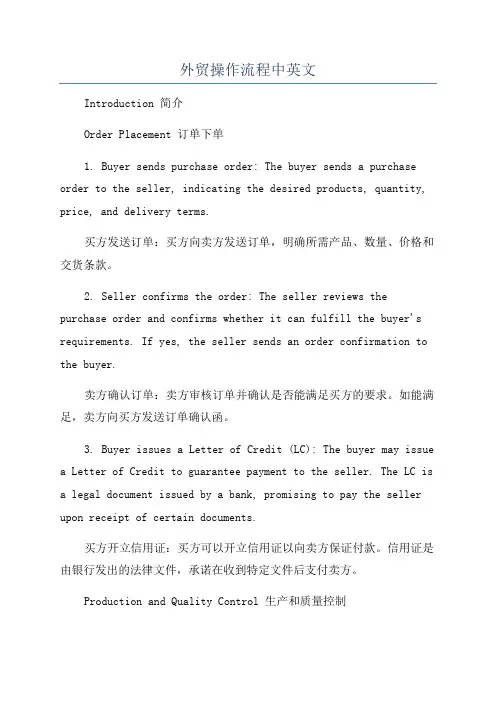
外贸操作流程中英文Introduction 简介Order Placement 订单下单1. Buyer sends purchase order: The buyer sends a purchase order to the seller, indicating the desired products, quantity, price, and delivery terms.买方发送订单:买方向卖方发送订单,明确所需产品、数量、价格和交货条款。
2. Seller confirms the order: The seller reviews the purchase order and confirms whether it can fulfill the buyer's requirements. If yes, the seller sends an order confirmation to the buyer.卖方确认订单:卖方审核订单并确认是否能满足买方的要求。
如能满足,卖方向买方发送订单确认函。
3. Buyer issues a Letter of Credit (LC): The buyer may issuea Letter of Credit to guarantee payment to the seller. The LC is a legal document issued by a bank, promising to pay the seller upon receipt of certain documents.买方开立信用证:买方可以开立信用证以向卖方保证付款。
信用证是由银行发出的法律文件,承诺在收到特定文件后支付卖方。
Production and Quality Control 生产和质量控制4. Production arrangement: Upon receiving the order confirmation, the seller arranges production and ensures the products are manufactured as per the buyer's specifications and quality requirements.生产安排:卖方在收到订单确认后,安排生产并确保产品按照买方的规格和质量要求生产。
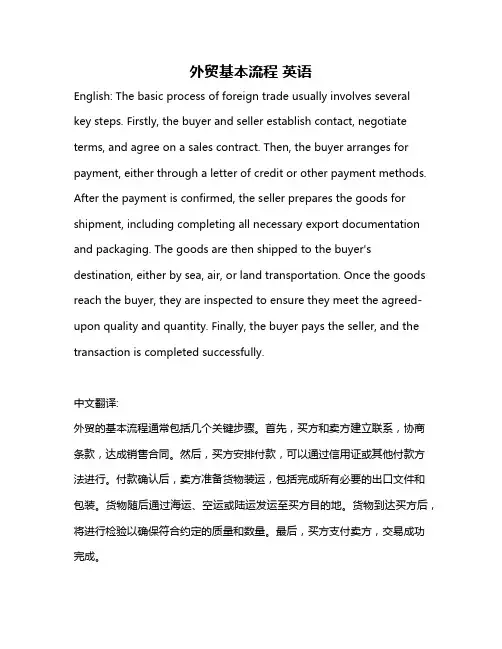
外贸基本流程英语English: The basic process of foreign trade usually involves several key steps. Firstly, the buyer and seller establish contact, negotiate terms, and agree on a sales contract. Then, the buyer arranges for payment, either through a letter of credit or other payment methods. After the payment is confirmed, the seller prepares the goods for shipment, including completing all necessary export documentation and packaging. The goods are then shipped to the buyer's destination, either by sea, air, or land transportation. Once the goods reach the buyer, they are inspected to ensure they meet the agreed-upon quality and quantity. Finally, the buyer pays the seller, and the transaction is completed successfully.中文翻译:外贸的基本流程通常包括几个关键步骤。
首先,买方和卖方建立联系,协商条款,达成销售合同。
然后,买方安排付款,可以通过信用证或其他付款方法进行。
付款确认后,卖方准备货物装运,包括完成所有必要的出口文件和包装。

外贸业务员的工作流程英语English: A foreign trade salesperson's workflow typically begins with market research to identify potential clients and understand market trends. Once potential clients are identified, the salesperson reaches out to them through various channels such as email, phone calls, or social media. Effective communication skills are crucial in this stage to establish rapport and convey the value proposition of the products or services offered. Negotiation plays a significant role as well, as the salesperson works to reach mutually beneficial agreements with clients regarding price, quantity, and delivery terms. Once an agreement is reached, the salesperson coordinates with other departments such as production, logistics, and finance to ensure smooth order processing and delivery. Post-sales activities involve maintaining relationships with clients, addressing any concerns or issues promptly, and seeking opportunities for upselling or cross-selling. Continuous market analysis and adaptation to changing market conditions are essential to stay competitive in the dynamic field of foreign trade.中文翻译: 外贸业务员的工作流程通常始于市场调研,以识别潜在客户并了解市场趋势。
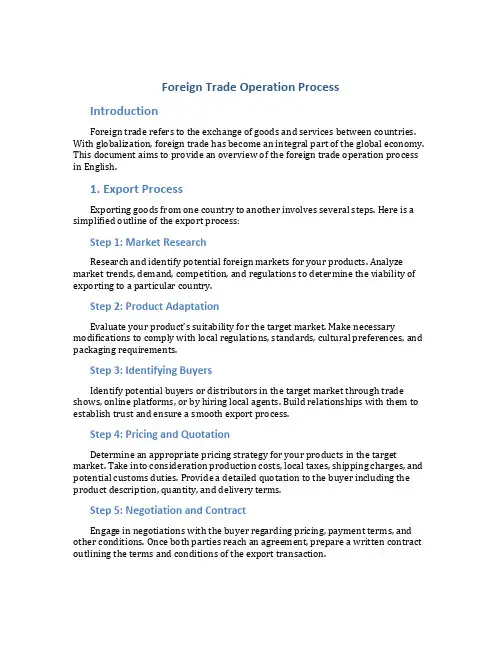
Foreign Trade Operation ProcessIntroductionForeign trade refers to the exchange of goods and services between countries. With globalization, foreign trade has become an integral part of the global economy. This document aims to provide an overview of the foreign trade operation process in English.1. Export ProcessExporting goods from one country to another involves several steps. Here is a simplified outline of the export process:Step 1: Market ResearchResearch and identify potential foreign markets for your products. Analyze market trends, demand, competition, and regulations to determine the viability of exporting to a particular country.Step 2: Product AdaptationEvaluate your product’s suitability for the target market. Make necessary modifications to comply with local regulations, standards, cultural preferences, and packaging requirements.Step 3: Identifying BuyersIdentify potential buyers or distributors in the target market through trade shows, online platforms, or by hiring local agents. Build relationships with them to establish trust and ensure a smooth export process.Step 4: Pricing and QuotationDetermine an appropriate pricing strategy for your products in the target market. Take into consideration production costs, local taxes, shipping charges, and potential customs duties. Provide a detailed quotation to the buyer including the product description, quantity, and delivery terms.Step 5: Negotiation and ContractEngage in negotiations with the buyer regarding pricing, payment terms, and other conditions. Once both parties reach an agreement, prepare a written contract outlining the terms and conditions of the export transaction.Prepare all necessary export documentation such as commercial invoices, packing lists, certificates of origin, and export licenses. Ensure compliance with both local and international trade regulations. Submit the required documents to customs authorities for clearance.Step 7: Shipment and LogisticsArrange for the transportation of goods to the buyer’s location. Select a f reight forwarder or shipping agent to handle the logistics, including packaging, labeling, and arranging for the necessary shipping documents. Track the shipment to ensure timely delivery.Step 8: Payment and FinancingAgree on the payment method with the buyer. Common options include letters of credit, wire transfers, or open account terms. Consider getting export credit insurance or financing from banks to mitigate the risk of non-payment.Step 9: After-sales SupportProvide after-sales support to the buyer, such as technical assistance, product training, or warranty services. Maintain regular communication with the buyer to address any concerns and build a long-term business relationship.2. Import ProcessImporting goods follows a similar process to exporting, with some additional steps. Here is a simplified outline of the import process:Step 1: Market ResearchResearch and identify potential foreign suppliers. Evaluate their reliability, product quality, pricing, and delivery capabilities. Consider any applicable trade restrictions or regulations for importing the desired goods.Step 2: Identifying SuppliersContact and establish relationships with potential suppliers. Request detailed information about the product specifications, prices, and payment terms. Arrange for product samples to assess their quality.Step 3: Negotiation and ContractNegotiate with the supplier regarding pricing, delivery terms, and any specific requirements. Once both parties reach an agreement, draft and sign a written contract that clearly defines the terms, conditions, and responsibilities of both parties.Obtain the necessary import licenses, permits, and certificates required by customs authorities. Ensure compliance with all applicable regulations and standards. Prepare and submit the required import documents such as commercial invoices, packing lists, and bills of lading to facilitate customs clearance.Step 5: Payment and FinancingAgree on the payment method with the supplier. Common options include letters of credit, wire transfers, or open account terms. Consider using trade financing options provided by banks to manage the financial aspects of the import transaction.Step 6: Shipment and LogisticsCoordinate with the supplier and freight forwarders to arrange for the shipment of goods. Determine the most suitable transportation mode based on cost, time, and the nature of the goods. Ensure that the goods are properly packaged, labeled, and insured during transit.Step 7: Customs Clearance and DutiesWork with customs authorities to clear the imported goods. Pay any applicable customs duties, taxes, or fees. Provide accurate and complete documentation to expedite the customs clearance process.Step 8: Product Inspection and ComplianceInspect the imported goods upon arrival to ensure they match the agreed-upon specifications and meet all quality standards and safety requirements. If necessary, arrange for third-party inspections or certifications.Step 9: Warehousing and DistributionUpon successful customs clearance, arrange for the storage and distribution of the imported goods. Coordinate with logistics providers to ensure timely delivery to the intended destination.Step 10: After-sales ServiceProvide after-sales support to address any issues or concerns with the imported goods. Establish communication channels with the supplier for warranty claims, repairs, or replacements.ConclusionThe foreign trade operation process involves several complex steps, requiring careful planning, market research, and adherence to regulations. By following theoutlined steps in the export and import processes, businesses can effectively engage in foreign trade and expand their market reach.。
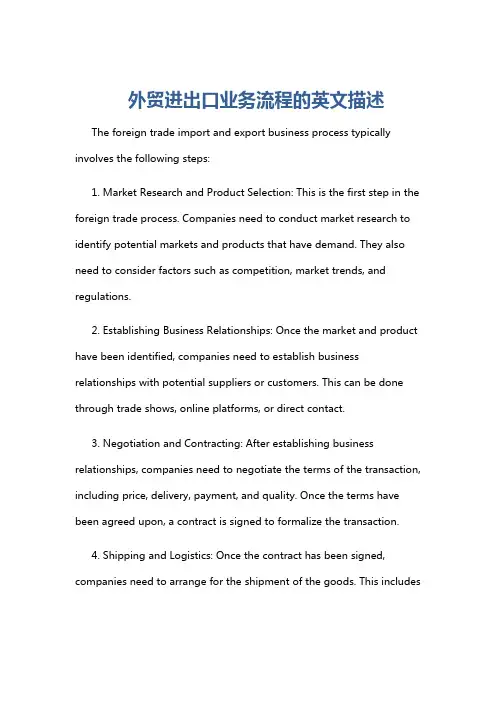
外贸进出口业务流程的英文描述The foreign trade import and export business process typically involves the following steps:1. Market Research and Product Selection: This is the first step in the foreign trade process. Companies need to conduct market research to identify potential markets and products that have demand. They also need to consider factors such as competition, market trends, and regulations.2. Establishing Business Relationships: Once the market and product have been identified, companies need to establish business relationships with potential suppliers or customers. This can be done through trade shows, online platforms, or direct contact.3. Negotiation and Contracting: After establishing business relationships, companies need to negotiate the terms of the transaction, including price, delivery, payment, and quality. Once the terms have been agreed upon, a contract is signed to formalize the transaction.4. Shipping and Logistics: Once the contract has been signed, companies need to arrange for the shipment of the goods. This includesselecting a shipping method, booking a shipping container, and handling customs clearance.5. Payment and Financing: Companies need to ensure that payment is received for the goods. This can be done through various payment methods, such as letters of credit, wire transfers, or cash. Financing options may also be available to help companies manage their cash flow.6. Documentation and Compliance: Companies need to ensure that all necessary documentation is completed and submitted accurately. This includes invoices, packing lists, and customs documents. They also need to comply with all relevant regulations and laws.7. After-Sales Service: Companies need to provide after-sales service to ensure customer satisfaction. This may include handling returns, providing technical support, or addressing any other issues that arise.In conclusion, the foreign trade import and export business process is a complex and multi-step process that requires careful planning, negotiation, and execution. By following these steps, companies can successfully engage in international trade and expand their business globally.。
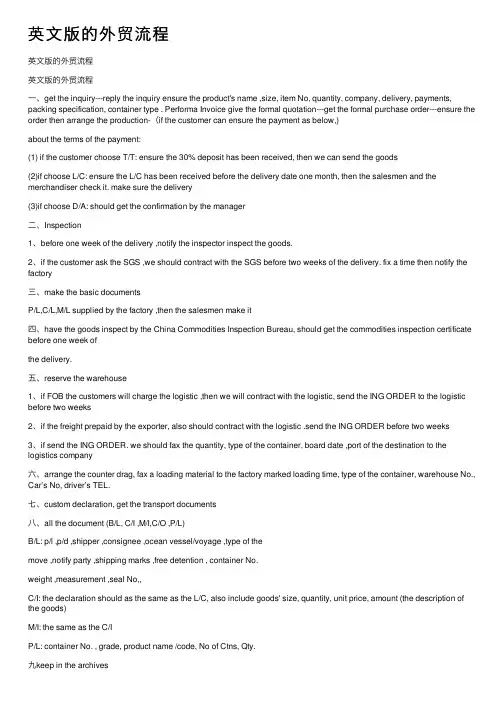
英⽂版的外贸流程英⽂版的外贸流程英⽂版的外贸流程⼀、get the inquiry---reply the inquiry ensure the product's name ,size, item No, quantity, company, delivery, payments, packing specification, container type . Performa Invoice give the formal quotation---get the formal purchase order---ensure the order then arrange the production-(if the customer can ensure the payment as below,)about the terms of the payment:(1) if the customer choose T/T: ensure the 30% deposit has been received, then we can send the goods(2)if choose L/C: ensure the L/C has been received before the delivery date one month, then the salesmen and the merchandiser check it. make sure the delivery(3)if choose D/A: should get the confirmation by the manager⼆、Inspection1、before one week of the delivery ,notify the inspector inspect the goods.2、if the customer ask the SGS ,we should contract with the SGS before two weeks of the delivery. fix a time then notify the factory三、make the basic documentsP/L,C/L,M/L supplied by the factory ,then the salesmen make it四、have the goods inspect by the China Commodities Inspection Bureau, should get the commodities inspection certificate before one week ofthe delivery.五、reserve the warehouse1、if FOB the customers will charge the logistic ,then we will contract with the logistic, send the ING ORDER to the logistic before two weeks2、if the freight prepaid by the exporter, also should contract with the logistic .send the ING ORDER before two weeks3、if send the ING ORDER. we should fax the quantity, type of the container, board date ,port of the destination to the logistics company六、arrange the counter drag, fax a loading material to the factory marked loading time, type of the container, warehouse No., Car’s No, driver’s TEL.七、custom declaration, get the transport documents⼋、all the document (B/L, C/I ,M/I,C/O ,P/L)B/L: p/l ,p/d ,shipper ,consignee ,ocean vessel/voyage ,type of themove ,notify party ,shipping marks ,free detention , container No.weight ,measurement ,seal No,,C/I: the declaration should as the same as the L/C, also include goods' size, quantity, unit price, amount (the description of the goods)M/I: the same as the C/IP/L: container No. , grade, product name /code, No of Ctns, Qty.九keep in the archives。
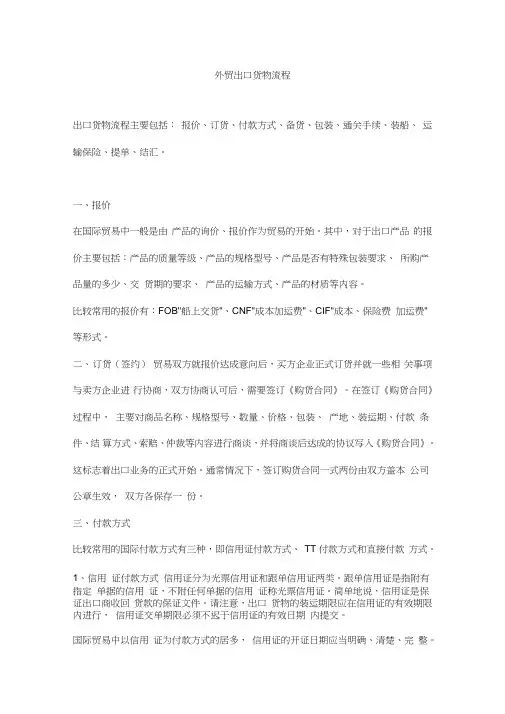
外贸出口货物流程出口货物流程主要包括:报价、订货、付款方式、备货、包装、通关手续、装船、运输保险、提单、结汇。
一、报价在国际贸易中一般是由产品的询价、报价作为贸易的开始。
其中,对于出口产品的报价主要包括:产品的质量等级、产品的规格型号、产品是否有特殊包装要求、所购产品量的多少、交货期的要求、产品的运输方式、产品的材质等内容。
比较常用的报价有:FOB"船上交货"、CNF"成本加运费"、CIF"成本、保险费加运费"等形式。
二、订货(签约)贸易双方就报价达成意向后,买方企业正式订货并就一些相关事项与卖方企业进行协商,双方协商认可后,需要签订《购货合同》。
在签订《购货合同》过程中,主要对商品名称、规格型号、数量、价格、包装、产地、装运期、付款条件、结算方式、索赔、仲裁等内容进行商谈,并将商谈后达成的协议写入《购货合同》。
这标志着出口业务的正式开始。
通常情况下,签订购货合同一式两份由双方盖本公司公章生效,双方各保存一份。
三、付款方式比较常用的国际付款方式有三种,即信用证付款方式、TT 付款方式和直接付款方式。
1、信用证付款方式信用证分为光票信用证和跟单信用证两类。
跟单信用证是指附有指定单据的信用证,不附任何单据的信用证称光票信用证。
简单地说,信用证是保证出口商收回货款的保证文件。
请注意,出口货物的装运期限应在信用证的有效期限内进行,信用证交单期限必须不迟于信用证的有效日期内提交。
国际贸易中以信用证为付款方式的居多,信用证的开证日期应当明确、清楚、完整。
中国的几家国有商业银行,如中国银行、中国建设银行、中国农业银行、中国工商银行等,都能够对外开立信用证(这几家主要银行的开证手续费都是开证金额的1.5%。
)。
2、TT 付款方式TT 付款方式是以外汇现金方式结算,由您的客户将款项汇至贵公司指定的外汇银行账号内,可以要求货到后一定期限内汇款。
3、直接付款方式是指买卖双方直接交货付款。
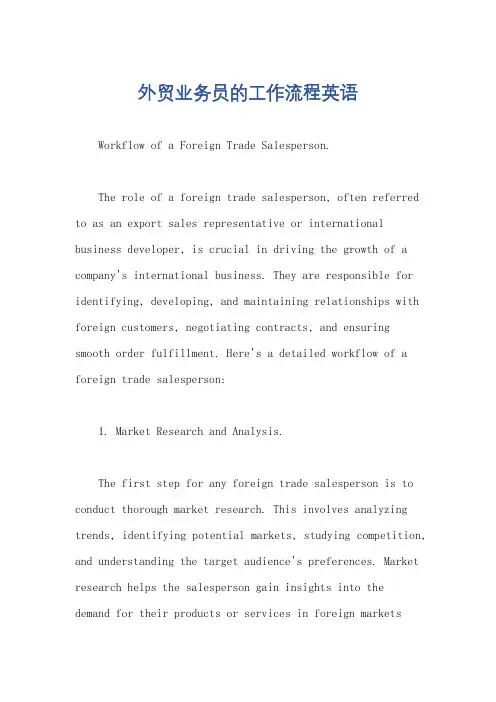
外贸业务员的工作流程英语Workflow of a Foreign Trade Salesperson.The role of a foreign trade salesperson, often referred to as an export sales representative or international business developer, is crucial in driving the growth of a company's international business. They are responsible for identifying, developing, and maintaining relationships with foreign customers, negotiating contracts, and ensuring smooth order fulfillment. Here's a detailed workflow of a foreign trade salesperson:1. Market Research and Analysis.The first step for any foreign trade salesperson is to conduct thorough market research. This involves analyzing trends, identifying potential markets, studying competition, and understanding the target audience's preferences. Market research helps the salesperson gain insights into the demand for their products or services in foreign marketsand identify any potential barriers to entry.2. Product Knowledge and Competitiveness Analysis.Having a deep understanding of the company's productsor services is crucial. The salesperson must be able to articulate the features, benefits, and unique sellingpoints of their offerings. Additionally, they must analyze how their products compare to those of competitors in the target market, identifying areas where their offerings have a competitive edge.3. Customer Identification and Prospecting.Identifying potential customers and prospects is a key task for foreign trade salespeople. They use various methods such as attending trade shows, using leadgeneration tools, and networking with industryprofessionals to identify potential buyers. Once identified, they create a prospect list and prioritize based on factors like market potential, customer size, and fit with the company's strategy.4. Contact Establishment and Lead Nurturing.The next step is to establish contact with the identified prospects. This involves initiating communication through emails, phone calls, or social media platforms. The salesperson then begins the lead nurturing process, building relationships by providing valuable information, answering queries, and addressing concerns. They strive to establish trust and demonstrate their expertise, positioning themselves as a reliable partner.5. Negotiation and Contract Formation.Once a prospect shows interest in the company's offerings, the salesperson moves on to negotiate terms and conditions. This involves discussing price, payment terms, delivery schedules, warranties, and other contractual details. The salesperson must be adept at negotiation, able to strike a balance between meeting the customer's needs and protecting the company's interests. Once an agreement is reached, they finalize the contract and ensure allparties sign it.6. Order Management and Fulfillment.After the contract is signed, the salesperson transitions to order management. They work closely with internal teams to ensure orders are processed and fulfilled according to the agreed terms. This involves coordinating with production, quality control, shipping, and other departments to ensure timely delivery of products or services. The salesperson also stays in close communication with the customer, keeping them updated on the order status and addressing any concerns or issues that arise.7. Post-Sales Support and Customer Retention.Excellent post-sales support is crucial in maintaining customer relationships and fostering loyalty. The salesperson is responsible for providing ongoing support, addressing any product or service issues, and ensuring customer satisfaction. They also work on retention strategies, such as providing value-added services,offering discounts or incentives, and staying in touch with regular updates and news.8. Performance Monitoring and Improvement.Lastly, foreign trade salespeople continuously monitor their performance, looking for areas of improvement. They analyze sales data, identify trends, and assess the effectiveness of their strategies. Based on these insights, they make adjustments to their approach, such as targeting different markets, optimizing pricing strategies, or improving product knowledge.In conclusion, the workflow of a foreign trade salesperson is diverse and challenging, requiring a blend of market intelligence, negotiation skills, andrelationship building. They must be able to navigate the complexities of international business, adapt to changing market conditions, and consistently deliver results that drive the company's growth.。
外贸业务员工作流程英文版As an international trade salesperson, my work process mainly includes the following steps:Firstly, I need to conduct market research to understand the demand, competition, and potential opportunities in the target market. This involves analyzing the current market situation, identifying potential customers, and understanding their needs and preferences.Next, I will reach out to potential clients throughvarious channels such as emails, phone calls, or social media.I will introduce our products or services, discuss their needs, and provide relevant information or solutions to meet their requirements.After identifying potential clients, I will negotiatewith them on price, delivery terms, payment methods, andother relevant terms. It is crucial to build a goodrelationship with clients during this stage and to ensurethat both parties are satisfied with the terms of the deal.Once an agreement is reached, I will prepare and send quotations, contracts, and other necessary documents to the clients. I will also coordinate with the relevant departments within our company to ensure that the products or servicescan be delivered as agreed.Throughout the entire process, I will keep in close communication with the clients to provide them with updateson their orders, address any concerns or issues they may have, and to maintain a good relationship for future business opportunities.In conclusion, the work process of an international trade salesperson involves market research, client outreach, negotiation, contract preparation, and ongoing client communication. It is a multi-step process that requireseffective communication, negotiation skills, and the ability to build and maintain relationships with clients.。
英文表达外贸工作流程下载温馨提示:该文档是我店铺精心编制而成,希望大家下载以后,能够帮助大家解决实际的问题。
文档下载后可定制随意修改,请根据实际需要进行相应的调整和使用,谢谢!并且,本店铺为大家提供各种各样类型的实用资料,如教育随笔、日记赏析、句子摘抄、古诗大全、经典美文、话题作文、工作总结、词语解析、文案摘录、其他资料等等,如想了解不同资料格式和写法,敬请关注!Download tips: This document is carefully compiled by theeditor. I hope that after you download them,they can help yousolve practical problems. The document can be customized andmodified after downloading,please adjust and use it according toactual needs, thank you!In addition, our shop provides you with various types ofpractical materials,such as educational essays, diaryappreciation,sentence excerpts,ancient poems,classic articles,topic composition,work summary,word parsing,copy excerpts,other materials and so on,want to know different data formats andwriting methods,please pay attention!My typical day kicks off with a morning ritual of checking emails and responding to inquiries. It's like opening a treasure chest; never know what gems I'll find!Negotiations can be a wild ride, like trying to tame a bucking bronco. You gotta be quick on your feet, ready to pivot and adapt to the ever-shifting landscape.When a deal's finally inked, it's time for the paperwork marathon. It's like a bureaucratic obstacle course, but with a killer soundtrack.Managing logistics is like playing chess with a global board. You gotta stay two moves ahead, anticipating potential snags and plotting your countermeasures.Communication is the lifeblood of our business. It's like a delicate dance, where every word and gesture carries weight. From client calls to team huddles, I'm the maestro of the information symphony.Problem-solving is our daily bread. When things go sideways, it's like being thrown into a stormy sea. But I've got a trusty life preserver called adaptability, and together, we navigate the choppy waters.Trade shows are like the Olympics of our industry. It's where we strut our stuff, showcase our latest innovations, and schmooze with potential partners.Customer service is the heart and soul of our game. It's like building a bridge of trust with every interaction, making sure our clients feel valued and supported.。
英文版进出口业务简易流程The import and export process involves several key steps that ensure goods move smoothly across international borders. Understanding this simplified workflow can help businesses efficiently manage their operations in global trade.1. Market Research and Feasibility Study:Before initiating any import or export activity, it's crucial to conduct thorough market research. This includes identifying potential markets, understanding consumer preferences, and assessing competition. The feasibility study should analyze costs, regulations, and logistics involved in reaching the target market or sourcing products.2. Product Sourcing and Compliance:For exports, businesses must source products that meet market demand and comply with export regulations. For imports, it's essential to ensure that the products adhere to theimport regulations of the destination country, including safety standards and labeling requirements. Engaging with suppliers and understanding compliance documentation will facilitate smoother transactions.3. Negotiating Terms and Agreements:Negotiating the terms of sale with suppliers or buyers is a critical step. This includes agreeing on prices, payment terms, delivery timelines, and Incoterms (International Commercial Terms) that clarify the responsibilities of buyers and sellers regarding transportation and insurance.4. Logistics Planning:Logistics involves organizing the transport of goods from departure to arrival. This may include selecting the appropriate shipping method (air, sea, or land), packing, labeling, and documentation such as commercial invoices, packing lists, and certificates of origin. Efficientlogistics planning minimizes shipping delays and cuts costs.5. Customs Clearance:Customs clearance is vital in the import/export process. It involves submitting required documentation to customs authorities to ensure compliance with laws and regulations. For exports, the necessary documentation may include export licenses, while imports typically require import permits. Proper classification and valuation of goods are essential to avoid penalties.6. Shipment Tracking:Once goods are dispatched, tracking shipments is crucial. Many logistics companies provide tracking services that allow businesses to monitor the location and status of their shipments. This transparency helps in managing expectations and resolving potential issues promptly.7. Payment and Financial Management:Financial transactions in international trade can be complex. Businesses should choose suitable payment methods such as letters of credit, advance payments, or open account terms. It’s essential to monitor currency fluctuations and manage risks associated with international payments.8. After-Sales Service:For exports, after-sales service may include follow-up communication to ensure customer satisfaction and handling returns or exchanges if necessary. Importers should also consider customer feedback for continuous improvement in their offerings.In summary, navigating the import and export process requires careful planning and execution across multiple stages. By adhering to this simplified workflow, businesses can enhance their operational efficiency and successful international trade activities.。
外贸操作流程中英文-CAL-FENGHAI-(2020YEAR-YICAI)_JINGBIAN1.外贸业务人员在国外采购商的询价,做出产品报价前,应了解客户基本信息,包括是否终端客户、年采购能力、消费区域,以及产品的用途、规格及质量要求,我公司是否能够生产等。
Before quoting, the Salesman should know the basic information about the clients, for instance, the end users or not, the annual order quantity, the places of consuming, and the products the purposes, specification, quality and the abilities whether our factories to meet.2.对于外商的邮件、传真,原则上在24小时内答复;特殊情况需要延期的,应及时向外商解释及大概需要的时间。
Generally as a rule, to reply the clients’ mails shall be within 24 hours after receiving; and please explain the reasons to the clients due to the things particular and need more time to deal with.3.对于外商的产品报价,原则上按照公司财务部门经核算后的价格表(外销)执行;公司财务部门根据市场状况及生产成本,定期进行核算,对产品价格进行调整。
Quotations will be according to the prices list (for oversea market) made by the company Accounting Department, which will make prices adjustments according to the market and the production cost at regular periods.4.对于定单数量较大,外商所能接受的价格低于我公司公布的价格的,业务人员应先上报部门经理批准实施;部门经理不能批复的,报总经理批准后实施。
外贸业务操作流程中英文公司内部编号:(GOOD-TMMT-MMUT-UUPTY-UUYY-DTTI-外贸业务操作流程(中英文)1、业务人员在国外采购商的询价,做出产品报价前,应了解客户基本信息,包括是否终端客户、年采购能力、消费区域,以及产品的用途、规格及质量要求,我公司是否能够生产等。
Before quoting, the Salesman should know the basic information about t he clients, for instance, the end users or not, the annual order quant ity, the places of consuming, and the products the purposes, specifica tion, quality and the abilities whether our factories to meet.2、对于外商的邮件、传真,原则上在24小时内答复;特殊情况需要延期的,应及时向外商解释及大概需要的时间。
Generally as a rule, to reply the clients’ mails shall be within 24 h ours after receiving; and please explain the reasons to the clients due to the things particular and need more time to deal with.3、对于外商的产品报价,原则上按照公司财务部门经核算后的价格表(外销)执行;公司财务部门根据市场状况及生产成本,定期进行核算,对产品价格进行调整。
Quotations will be according to the prices list (for oversea market) m ade by the company Accounting Department, which will make prices adjus tments according to the market and the production cost at regular peri ods.4、对于定单数量较大,外商所能接受的价格低于我公司公布的价格的,业务人员应先上报部门经理批准实施;部门经理不能批复的,报总经理批准后实施。
外贸英语的业务流程外贸英语的业务流程是指国内企业通过与国外客户进行交流、洽谈和合作,从而开展国际贸易的一系列步骤和流程。
下面是一个关于外贸英语的业务流程的参考内容。
第一步:市场调研和分析进行市场调研和分析是外贸业务的第一步。
通过了解国际市场的需求、竞争对手以及贸易政策等因素,企业可以制定切实可行的出口计划和策略。
第二步:产品准备和改进在进入国际市场之前,企业需要对自己的产品进行准备和改进。
这包括确定出口产品、进行质量和标准的认证、设计出口包装等。
第三步:寻找国外客户一旦产品准备就绪,企业需要寻找国外客户。
这可以通过参加国际贸易展览会、发布产品目录、在国际贸易网站上发布产品信息等方式来实现。
第四步:洽谈和报价一旦有了潜在的国外客户,接下来的步骤是进行洽谈和报价。
这需要使用外贸英语进行书面和口头的沟通,并提供详细的产品信息和报价单。
第五步:合同签订当双方就产品、价格、付款条件等方面达成一致后,接下来需要签订合同。
合同是国际贸易中的法律文件,需要确保合约条款的准确和合法性。
第六步:支付和货物运输一旦合同签订,接下来是支付和货物运输。
通常情况下,国外客户需要提前支付一定比例的订金或开立信用证。
货物运输可以通过航空运输、海运或陆运来实现。
第七步:报关和清关货物到达目的地国家后,需要进行报关和清关手续。
这包括提交必要的文件,如发票、装箱单、报关单等,并缴纳关税和其他相关费用。
第八步:售后服务一旦货物到达并被客户接收,企业需要提供售后服务。
这包括解答客户的问题、提供产品保修和维护服务等,以确保客户的满意度和忠诚度。
第九步:开展市场营销除了与特定客户的合作外,企业还应该开展市场营销活动,以扩大自己的知名度和市场份额。
这可以通过广告宣传、参加市场活动、与业内协会合作等方式实现。
第十步:客户反馈和改进在开展外贸业务的过程中,企业需要及时收集客户的反馈信息,并进行改进和调整。
客户的反馈对于产品质量改进、服务提升以及开展新产品开发都非常重要。
外贸业务操作流程(中英文)1、业务人员在国外采购商的询价,做出产品报价前,应了解客户基本信息,包括是否终端客户、年采购能力、消费区域,以及产品的用途、规格及质量要求,我公司是否能够生产等。
Before quoting, the Salesman should know the basic information about the clien ts, for instance, the end users or not, the annual order quantity, the places of consuming, and the products the purposes, specification, quality and the ab ilities whether our factories to meet.2、对于外商的邮件、传真,原则上在24小时内答复;特殊情况需要延期的,应及时向外商解释及大概需要的时间。
Generally as a rule, to reply the clients’ mails shall be within 24 hours aft er receiving; and please explain the reasons to the clients due to the things particular and need more time to deal with.3、对于外商的产品报价,原则上按照公司财务部门经核算后的价格表(外销)执行;公司财务部门根据市场状况及生产成本,定期进行核算,对产品价格进行调整。
Quotations will be according to the prices list (for oversea market) made by t he company Accounting Department, which will make prices adjustments according to the market and the production cost at regular periods.4、对于定单数量较大,外商所能接受的价格低于我公司公布的价格的,业务人员应先上报部门经理批准实施;部门经理不能批复的,报总经理批准后实施。
For big orders, the acceptable price from the clients is lower than our listed price, the salesman shall first report this to the manager of the departments for approval; and when the manager have no rights to approve, the price will directly go to the general manager for approval.5、对于C&F及CIF报价,需要我方办理运输、保险的或需要进行法定检验的等事项,业务人员应事先联系相关中介机构进行确定,选择中介机构应考虑业务熟练、服务效率高及收费合理。
??In C&F or CIF price terms, the salesman shall contact and deal with related co mpanies in advance to confirm the things of shipment, insurance, commodity ins pection etc. The basic conditions for selecting the related companies will be considering rich and professional practices, service with high efficiency and good prices.6、对于外商的寄样要求,原则上要求到付;对于样品数额较大,原则上对方承担成本费用。
在正式定单后,可以扣除成本及寄样费用。
特殊情况,如关系比较好的老客户,我方可以预付并免收样品,报部门经理批准后执行。
费用较大的,可报总经理批准后执行。
Per the clients’ requirements of sending samples, freight collect shall be ge nerally required; and when the samples quantity is large, the cost shall be ch arged accordingly. However the cost and freight paid by the clients will be de ducted in the trial orders. In cases particular, for instance the clients with long term and firm relations, we can pay the freight in advance with the samp les free after approved by the manager of the departments,or by the general m anager if the amount is large.7、对于外商需要打样的,业务人员应和生产部门协调,确保样品的质量及规格符合要求;样品需要部门经理审核后寄出;外商对于产品有包装或唛头要求的,正式包装或印刷前需经外商确认。
The salesman shall coordinate closely with the production departments in the s amples making process to guarantee the quality and specifications meeting the clients’ requirements, and send the samples after the approval by the final c hecking up of manager department.8、付款方式上,原则上考虑前TT全部或部分作为定金,剩余见提单传真件付款,及全部短期信用证。
收汇银行和业务员负责对信用证做形式和内容的检查,发现差异的,应及时通知外商修改。
信用证审查无误后,报部门经理复核。
Generally as a rule, the following ways of payments will be considered:1, wire transfer 100 in advance2, wire transfer part as deposit, the balance against copy of B/L.3, 100% L/C at sightOur beneficiary bank and the salesman will check up the L/C in form and conten ts respectively, and inform the clients to make change in time if differences existing, and submit to the manager of the departments for re-checking after n o faults or differences found in advance..9、原则上,公司在收到外商的全部货款、部分定金及信用证经复核无误后,开始安排生产计划,组织货源,进行生产。
As a general rule, the company will arrange the material and plan for producti on after receiving the payments in above No.8 terms.10、在定单生产阶段,业务人员应到生产车间会同生产主管对产品生产进行监督、检查,发现问题及时解决;或由部门经理协调解决,或部门经理上报总经理解决。
严格把握产品的规格、质量、包装、生产时间符合同外商的约定。
In the production processing, the salesman shall be at the workshop to supervi se and inspect the production with the person in charge, to find and solve the problems in time, or to report the problems to the manager of the department for coordinating to solve, or to report to the general manager for solving, to guarantee the specification, the quality, the packing and production time acc ording to the requirements of the clients.11、对于C&F、CIF价格条款的,业务人员应在生产结束前一周,安排好货代,确定定舱事宜;一般在船期前二日,安排装柜、运输。
In C&F and CIF price terms, the salesman shall arrange and confirm the shipmen ts with the related agents a week in advance, and to load the goods to the con tainer and transport the goods two days in advance.11、需要委托中介机构进行报关、商品法定检验、保险的,业务人员应及时准备相关资料交中介机构办理;办理过程中,业务人员可以协助。
The salesman will prepare the concerned documents for the Customs declaration, Specified goods’ inspection and Insurance by related departments if needed; the salesman can make coordination in the process.12、收汇方式为信用证的,业务人员必须细心操作,谨慎处理,注意单证的一致性,做到安全收汇。